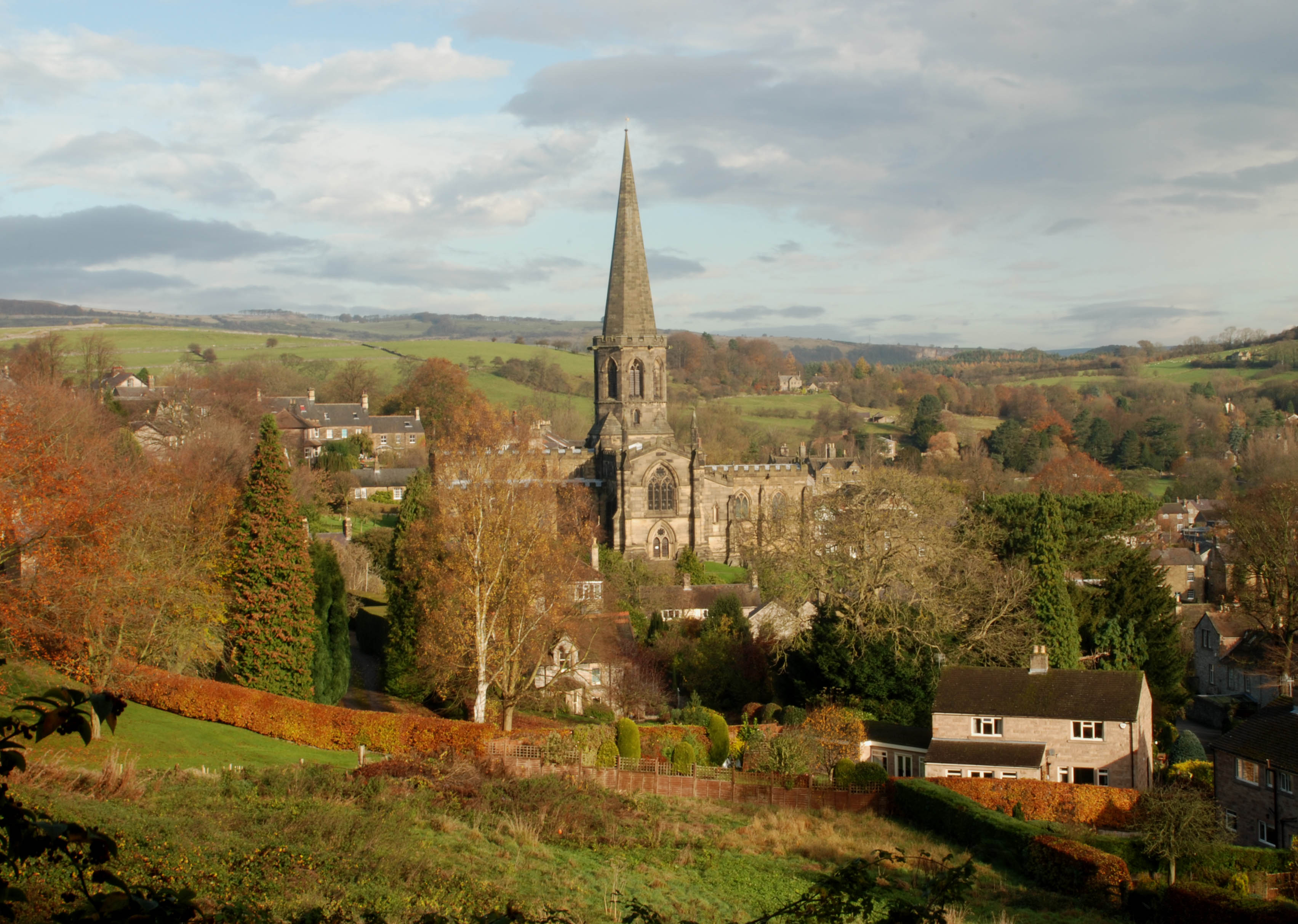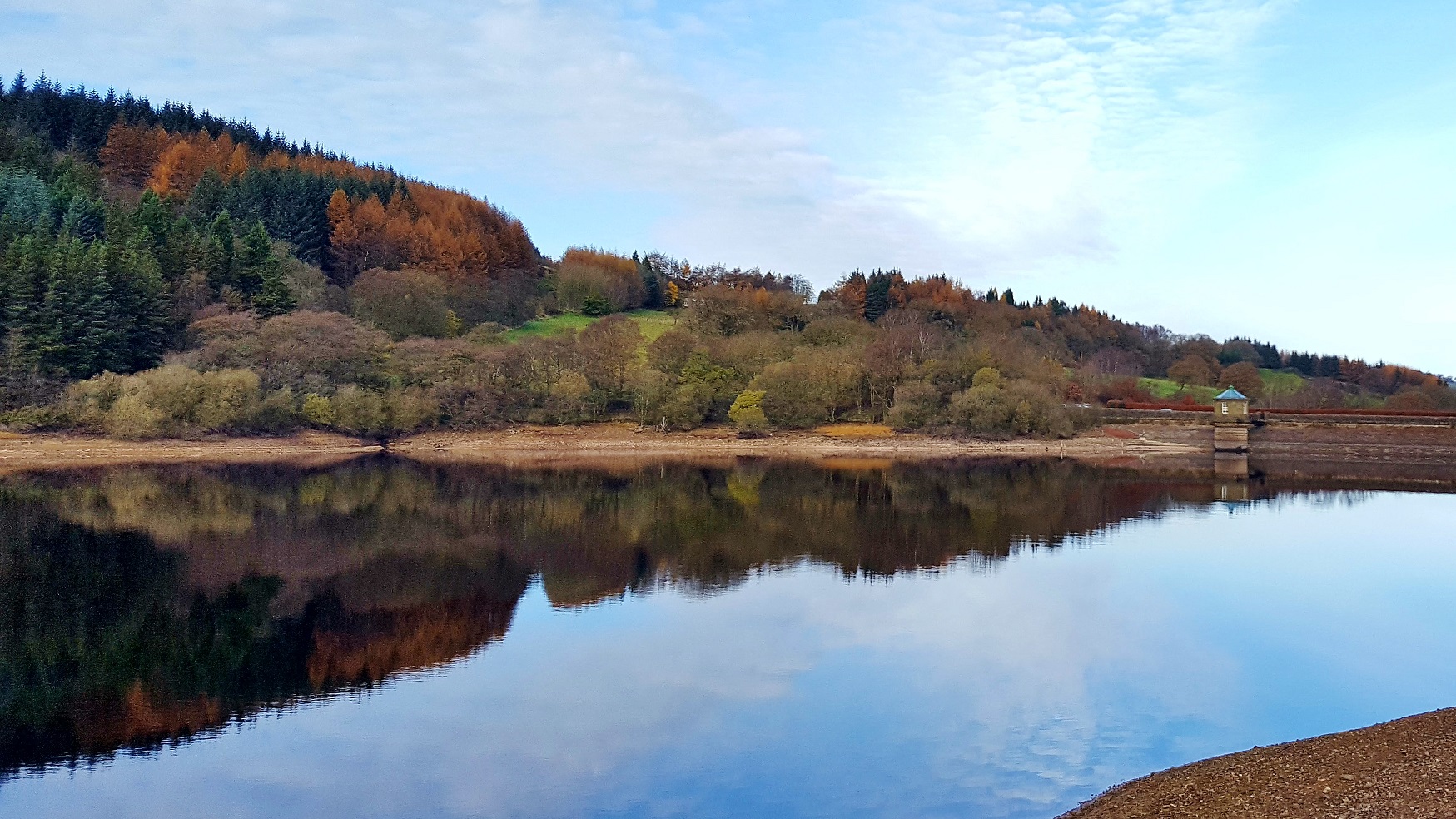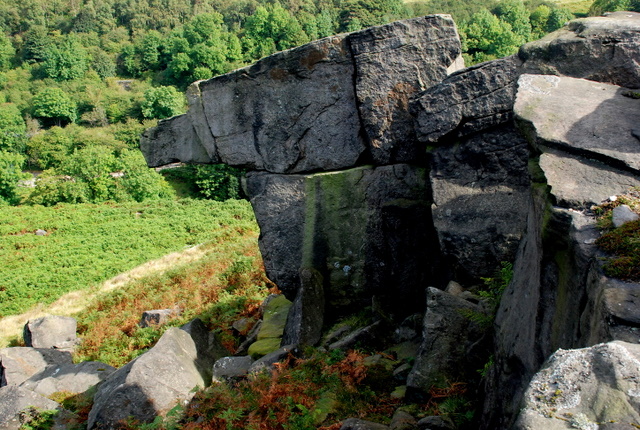|
Hob Hurst's House
Hob Hurst's House is a Bronze Age barrow on Beeley Moor near Bakewell in Derbyshire. It is unique in that instead of the normal round shape, Hob Hurst's barrow is rectangular. Originally made with 13 stones, only five remain today. It is situated on the highest part of Beeley Moor. It is in diameter and high, with a ditch and an external bank of diameter. There are numerous prehistoric mounds on these moors, many marking late Neolithic and early Bronze Age burial sites. Built by local families in their fields and open pastures to contain the bones of 'ancestors', the mounds were visible symbols of community sense of place. However Hob Hurst's House is unique with its square central mound, ditch and outer bank. Hob Hurst's House was one of the first monuments in Britain to be taken into state care, through the Ancient Monuments Protection Act of 1882. The stone bollards inscribed VR that surround the site were erected at that time. The curious name Hob Hurst's House refers t ... [...More Info...] [...Related Items...] OR: [Wikipedia] [Google] [Baidu] |
Round Barrow
A round barrow is a type of tumulus and is one of the most common types of archaeological monuments. Although concentrated in Europe, they are found in many parts of the world, probably because of their simple construction and universal purpose. In Britain, most of them were built between 2200BC and 1100BC. This was the Late Neolithic period to the Late Bronze Age. Later Iron Age barrows were mostly different, and sometimes square. Description At its simplest, a round barrow is a hemispherical mound of earth and/or stone raised over a burial placed in the middle. Beyond this there are numerous variations which may employ surrounding ditches, stone kerbs or flat berms between ditch and mound. Construction methods range from a single creation process of heaped material to a complex depositional sequence involving alternating layers of stone, soil and turf with timbers or wattle used to help hold the structure together. The center may be placed a stone chamber or cist or in a ... [...More Info...] [...Related Items...] OR: [Wikipedia] [Google] [Baidu] |
Beeley Moor
Beeley Moor is a small gritstone upland area in the Derbyshire Peak District of central and northern England, near the villages of Beeley and Baslow. Its highest point is above sea level. Geography The Chatsworth Estate lies to the north west. East Moor is the broader moorland area covering Gibbet Moor, Brampton East Moor and Beeley Moor.The River Hipper's source is on Beeley Moor at Hipper Sick. Beeley Brook also drains from the moor and features several cascades as it runs to Beeley village. History Beeley Moor is a prehistoric landscape with many protected Scheduled Ancient Monuments including individual cairns, cairn fields, burial mounds and guidestones. Hob Hurst's House is an unusual square Bronze Age burial cairn on Harland Edge (between Gibbet Moor and Beeley Moor). Thomas Bateman excavated the barrow in 1853 and discovered a stone cist containing cremated remains. It has been a protected national monument since 1882. The site was named after a goblin who was su ... [...More Info...] [...Related Items...] OR: [Wikipedia] [Google] [Baidu] |
Bakewell
Bakewell is a market town and civil parish in the Derbyshire Dales district of Derbyshire, England, known also for its local Bakewell pudding. It lies on the River Wye, about 13 miles (21 km) south-west of Sheffield. In the 2011 census, the population of the civil parish appeared as 3,949. It was estimated at 3,695 in 2019. The town is close to the tourist attractions of Chatsworth House and Haddon Hall. History Although there is evidence of earlier settlement in the area, Bakewell itself was probably founded in Anglo-Saxon times in the Anglian kingdom of Mercia. The name Bakewell means a spring or stream of a woman named Badeca or Beadeca, so deriving from a personal name with the Old English suffix ''wella''. In 949 it was called Badecanwelle and in the 1086 Domesday Book ''Badequelle''. The Domesday book listing stated that King Edward held land here; the settlement had a church and a mill. These are the outlying estates or berewicks of the manor: Haddon addon or Ov ... [...More Info...] [...Related Items...] OR: [Wikipedia] [Google] [Baidu] |
Derbyshire
Derbyshire ( ) is a ceremonial county in the East Midlands, England. It includes much of the Peak District National Park, the southern end of the Pennine range of hills and part of the National Forest. It borders Greater Manchester to the north-west, West Yorkshire to the north, South Yorkshire to the north-east, Nottinghamshire to the east, Leicestershire to the south-east, Staffordshire to the west and south-west and Cheshire to the west. Kinder Scout, at , is the highest point and Trent Meadows, where the River Trent leaves Derbyshire, the lowest at . The north–south River Derwent is the longest river at . In 2003, the Ordnance Survey named Church Flatts Farm at Coton in the Elms, near Swadlincote, as Britain's furthest point from the sea. Derby is a unitary authority area, but remains part of the ceremonial county. The county was a lot larger than its present coverage, it once extended to the boundaries of the City of Sheffield district in South Yorkshire where it cov ... [...More Info...] [...Related Items...] OR: [Wikipedia] [Google] [Baidu] |
Thomas Bateman
Thomas Bateman (8 November 1821 (baptised) – 28 August 1861) was an English antiquary and barrow-digger. Biography Thomas Bateman was born in Rowsley, Derbyshire, England, the son of the amateur archaeologist William Bateman. After the death of his father in 1835, Bateman was raised by his grandfather, and from the age of 16 he helped run the family estate at Middleton Hall in Middleton-by-Youlgreave, during which time he became interested in archaeology: Sir Richard Colt Hoare's ''Ancient History of North and South Wiltshire'' influenced him greatly. He built Lomberdale Hall in 1844 as his private residence. Bateman had a long affair with Mary Ann Mason, but she was already married. He married Sarah Parker on 2 August 1847 and they had four daughters and a son. Bateman's first archaeological experience was observing the demolition of a medieval church in Bakewell. He joined the British Archaeological Association in 1843 and in 1844, whilst at an archaeological congress in C ... [...More Info...] [...Related Items...] OR: [Wikipedia] [Google] [Baidu] |
English Heritage
English Heritage (officially the English Heritage Trust) is a charity that manages over 400 historic monuments, buildings and places. These include prehistoric sites, medieval castles, Roman forts and country houses. The charity states that it uses these properties to "bring the story of England to life for over 10 million people each year". Within its portfolio are Stonehenge, Dover Castle, Tintagel Castle and the best preserved parts of Hadrian's Wall. English Heritage also manages the London Blue Plaque scheme, which links influential historical figures to particular buildings. When originally formed in 1983, English Heritage was the operating name of an executive non-departmental public body of the British Government, officially titled the Historic Buildings and Monuments Commission for England, that ran the national system of heritage protection and managed a range of historic properties. It was created to combine the roles of existing bodies that had emerged from a long ... [...More Info...] [...Related Items...] OR: [Wikipedia] [Google] [Baidu] |
Peak District Boundary Walk
The Peak District Boundary Walk is a circular walking trail, starting and finishing at Buxton and broadly following the boundary of the Peak District, Britain's first national park. The route was developed by the Friends of the Peak District (a branch of the Campaign to Protect Rural England) and was launched on 17 June 2017. The Friends of the Peak District's founders, Gerald and Ethel Haythornthwaite, proposed the boundary of the Peak District National Park, which was subsequently established as the United Kingdom's first National Park in 1951. The route is waymarked with green markers and uses existing footpaths, tracks, quiet lanes, disused railway lines and a canal towpath. The start and finish is at the King's Head pub on Buxton Market Place, where a plaque has been installed by the Peak & Northern Footpaths Society (PNFS). The terrain covers open moorlands of the South Pennines, the limestone scenery of the Derbyshire Dales, woodlands, reservoirs and rural farming ... [...More Info...] [...Related Items...] OR: [Wikipedia] [Google] [Baidu] |
Gibbet Moor
Gibbet Moor is a small gritstone upland area in the Derbyshire Peak District of central and northern England, near the village of Baslow. Its highest point is above sea level. The Chatsworth Estate lies to the west and Umberley Brook run along its east edge. East Moor is the broader moorland area covering Gibbet Moor, Brampton East Moor and Beeley Moor. Gibbet Moor is a prehistoric landscape with several protected Scheduled Ancient Monuments. A gibbet was a wooden structure (like a gallows), where the dead bodies of criminals were hung on display. The last person to be gibbeted alive in England was a vagrant who was begging for food around Baslow and killed a woman in her cottage. The murderer was left to die in a gibbet cage on Gibbet Moor in the 17th century. A widespread Bronze Age settlement covers a stretch of moorland over 1km long. The complex includes a stone circle, more than 250 cairns, cemeteries of burial mounds (barrows) and remains of field enclosures and buildi ... [...More Info...] [...Related Items...] OR: [Wikipedia] [Google] [Baidu] |
Beeley
Beeley is a village and civil parish in northern Derbyshire, England. Located near Bakewell in the Derbyshire Dales, it is situated on the B6012 road, between Rowsley and Edensor. The civil parish population at the 2011 Census was 195. It is part of the Peak District National Park, and has been part of the Chatsworth estate since the 18th century, when the Duke of Devonshire bought Beeley Hill Top and then much of the property piecemeal. Beeley Old Hall dates from the 17th century. On School Lane there is an outdoor centre called Dukes Barn. The Peak District Boundary Walk The Peak District Boundary Walk is a circular walking trail, starting and finishing at Buxton and broadly following the boundary of the Peak District, Britain's first national park. The route was developed by the Friends of the Peak District (a ... runs through the village. See also * Listed buildings in Beeley * Pilsley, another Chatsworth estate village References External links History of th ... [...More Info...] [...Related Items...] OR: [Wikipedia] [Google] [Baidu] |
Archaeological Sites In Derbyshire
Archaeology or archeology is the scientific study of human activity through the recovery and analysis of material culture. The archaeological record consists of artifacts, architecture, biofacts or ecofacts, sites, and cultural landscapes. Archaeology can be considered both a social science and a branch of the humanities. It is usually considered an independent academic discipline, but may also be classified as part of anthropology (in North America – the four-field approach), history or geography. Archaeologists study human prehistory and history, from the development of the first stone tools at Lomekwi in East Africa 3.3 million years ago up until recent decades. Archaeology is distinct from palaeontology, which is the study of fossil remains. Archaeology is particularly important for learning about prehistoric societies, for which, by definition, there are no written records. Prehistory includes over 99% of the human past, from the Paleolithic until the advent of ... [...More Info...] [...Related Items...] OR: [Wikipedia] [Google] [Baidu] |
Scheduled Monuments In Derbyshire
There are over 500 scheduled monuments in the English county of Derbyshire. In the United Kingdom, a scheduled monument is a "nationally important" archaeological site or historic building that has been given protection against unauthorised change by being placed on a list (or "schedule") by the Secretary of State for Culture, Media and Sport; English Heritage takes the leading role in identifying such sites. Scheduled monuments are defined in the Ancient Monuments and Archaeological Areas Act 1979 and the National Heritage Act 1983. They are also referred to as scheduled ancient monuments. There are about 20,000 Scheduled Monument entries on the list, which is maintained by English Heritage; more than one site can be included in a single entry. While a scheduled monument can also be recognised as a listed building, English Heritage considers listed building status as a better way of protecting buildings than scheduled monument status. If a monument is considered by English Heri ... [...More Info...] [...Related Items...] OR: [Wikipedia] [Google] [Baidu] |



.jpg)


.jpg)
